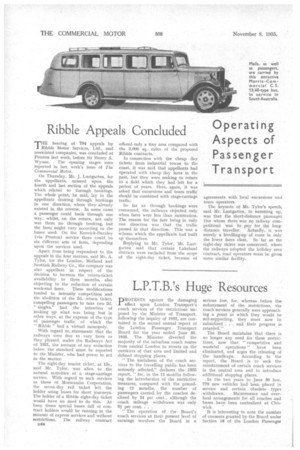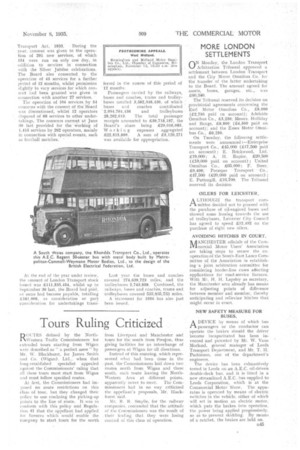L.P.T.B.'s Huge Resources
Page 198

Page 199

If you've noticed an error in this article please click here to report it so we can fix it.
PROTESTS against the damaging effect upon London Transport's coach services of the restrictions imposed by the Minister of Transport, following the inquiry of 1932, are contained in the second annual report of the London Passenger Transport Board for the year ended June 30, 1935. The Minister diverted the majority of the suburban coach routes from central London to streets on the outskirts of that area and limited and defined stopping places.
" The usefulness of the coach services to the travelling public has been seriously affected," declares the 1935 report, "for, in the 12 months following the introduction of the restrictive measures, compared with the preceding 12 months, the number of passengers carried by the coaches declined by 24 per cent., although the coach mileage withdrawn was only 9iper cent. . .
" The operation of the Board's coach services at their present level of earnings involves the Board in a
serious loss, for, whereas before the enforcement of the restrictions, the coach services generallywere approaching a point at which they would be self-supporting, they must now be subsidized . . . and their progress is retarded."
The Board maintains that there is no longer any need for these restrictions, now that " competitive and wasteful operations 'S have been eliminated, and urges the releasing of the handicaps. According to the report, the Board is to seek the reinstatement of certain coach services in the central area and to introduce additional stopping places.
In the two years to June 30 last, 779 new vehicles had been placed in service and certain obsolete types
withdrawn. Maintenance and overhaul arrangements for all coaches and buses have been centralized at Chiswick.
It is interesting to note the number of consents granted by the Board under Section 16 of the London Passenger Transport Act: 1933;During the year, consent was given to the operation of 201 new services, of which 154 were run on only one day, in a.cldilion to services in connection with the Silver Jubilee celebrations. The Board also consented. to the operation of 45 servicesfor a further period of 12 Months, whilst permission slightly to vary services for which consent had been granted was given in connection with another 27 services.
The operation of 104 services :by 54 concerns with the consent of the Board was discontinued, whilst 12 operators disposed of 68 cervices to other undertakings. The consents current at June 30 last provided for the :Working of 1,415 services by 262 operators, mainly in connection with special events, such as football matches.
At the end of the year under review, the amount of London Transport stock issued was £111,535,454, whilst up to September 30 last, the Board had paid, or sums had become payable, totalling £161,606, as consideration or part consideration for undertakings trans
(erred in the course of this period of 12 months.
Passengers carried by the railways, buses and coaches, trams and trolleybuses totalled 3,582,348,430, of which buses and coaches contributed
2,094,764,436 and trolleybuses 28,262,013. The total passenger receipts amounted to £39,718,187, the Board's share being £29,016,085. Working expenses aggregated £22,515,889. A sum of £5,126,271 was available for appropriation.
Last year the buses and coaches covered 274,639,723 miles, and the trolleybuses 2,743,858. combined, the railways, buses and coaches, trams and trolleybuses covered 533,835,733 miles.
A statement for 1934 has also just been issued,












































































































































































































































































































